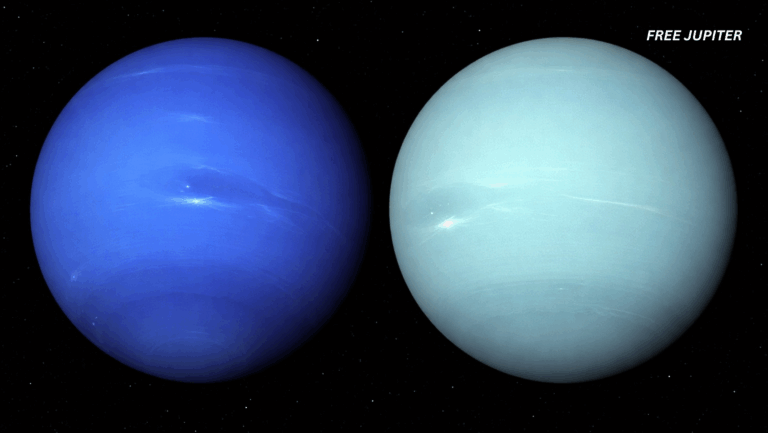If you look up at the night sky, the Moon feels like a constant—always hanging there, glowing quietly above us. But here’s the twist: it isn’t standing still. Every year, the Moon drifts about 1.5 inches (3.8 centimeters) farther away from Earth. That’s roughly the width of a large marble. While that might sound tiny, across millions of years, it adds up to something massive.
Scientists figured this out in an unusual but clever way—by shooting lasers at the Moon. During the Apollo missions, astronauts placed mirrors on the lunar surface. When researchers beam light at these mirrors, they measure how long it takes for the laser to return. Because light travels at a constant speed, they can calculate the exact distance to the Moon down to fractions of an inch. The results show the Moon is indeed drifting away, and slowly but surely, Earth’s days are changing too.
The Tidal Tug-of-War
At the heart of this lunar drift is something familiar: tides. Most people think of tides as water rushing in and out at the beach, but they are actually the visible effect of the Moon’s gravity tugging unevenly on Earth. The side of Earth facing the Moon experiences a slightly stronger pull than the far side, creating two bulges in the oceans—one that faces the Moon and one on the opposite side.
Because Earth spins much faster than the Moon orbits, these bulges don’t line up perfectly. Instead, they’re dragged a little ahead of the Moon’s position. And here’s where things get fascinating: those bulges tug back on the Moon, giving it a small but steady push forward in its orbit. That forward nudge adds momentum, causing the Moon to spiral outward, inch by inch, year by year.
Read more: Scientists Confirm Earth’s Hidden “Second Moon” After 60 Years Of Hiding
How Earth Pays the Price
The Moon’s gain in momentum doesn’t come for free—it costs Earth something in return. Each time the tidal bulges give the Moon a push, Earth slows its spin ever so slightly. Over millions of years, this means the length of a day gradually increases. Scientists estimate that around 70 million years ago, a day on Earth lasted about 23.5 hours. Fossilized clams even hold growth rings that confirm this ancient rhythm.
But don’t worry—this change is too slow to affect your calendar. The extra length added to a day is measured in milliseconds per century, so we’re still safely locked into our 24-hour cycle. In fact, we’ll continue to enjoy tides, eclipses, and the familiar rhythm of the Moon for millions of years to come, even as these subtle shifts continue in the background.
Did the Moon Look Bigger in the Past?
Absolutely—and much bigger. The Moon likely formed around 4.5 billion years ago when a Mars-sized object collided with early Earth. The impact threw debris into orbit, which later clumped together to form the Moon. In those days, the Moon was far closer to Earth than it is now, looming large in the sky like a glowing giant.
As the eons passed, the Moon gradually retreated, shrinking in apparent size from our perspective. Evidence of shorter Earth days millions of years ago lines up perfectly with this idea. Fossil records and astronomical models both confirm that our planet’s rotation has slowed over time as the Moon crept outward, changing the relationship between day length and lunar distance.
What Happens in the Far Future?
Fast-forward billions of years, and the Earth-Moon dance could look very different. If things continue as they are, Earth’s spin will eventually slow down until one side of Earth always faces the Moon—a state called tidal locking. At that point, the Moon will stop drifting away, settling into a stable orbit where both bodies show only one face to each other.
But reality may cut the story short. In about a billion years, the Sun will grow brighter, boiling away Earth’s oceans. Without oceans, the tidal bulges that fuel the Moon’s drift will vanish, halting its gradual escape. A few billion years after that, the Sun will balloon into a red giant, likely consuming or destroying both Earth and the Moon. It’s a dramatic ending, but so far in the future that for now, our lunar companion remains safe.
Read more: Rogue Planets Floating in Deep Space May Be Forming Their Own Moons
Subtopic: Supermoons, Blood Moons, and Lunar Eclipses
The Moon’s wobbly orbit doesn’t just make it drift away; it also produces spectacular sky shows. When a full Moon happens while it’s at its closest point to Earth, we get what’s called a supermoon. These appear slightly larger and brighter than an ordinary full Moon, and while the difference is subtle, it’s enough to excite skywatchers around the globe.
Other celestial events add even more variety. During a total lunar eclipse, Earth blocks sunlight from directly reaching the Moon. Instead, light filters through Earth’s atmosphere, turning the Moon a deep coppery red—a so-called blood moon. And if you ever hear about a blue moon, that doesn’t mean the Moon is actually blue; it’s simply the term for a rare second full Moon in a single month.
Subtopic: Other Moons in the Solar System
Our Moon isn’t the only world affected by tidal forces. In fact, many of the solar system’s moons are shaped by similar gravitational dramas. Take Io, one of Jupiter’s moons. Constantly stretched and squeezed by Jupiter’s gravity and its fellow moons, Io is the most volcanically active world we know, with eruptions so powerful they can be spotted from space.
Saturn’s moon Enceladus offers a different kind of spectacle. Tidal stress cracks its icy surface, allowing water vapor to shoot out into space like geysers. Beneath its frozen crust, scientists suspect there’s a hidden ocean—one that might even harbor the ingredients for life. Studying our Moon’s tides helps us understand these distant and exotic places.
Subtopic: What This Means for Us
The thought of the Moon drifting away might sound unsettling, but in reality, its effects on our lives are minimal. Tides will still wash across beaches, fishermen will still rely on the Moon’s pull, and eclipses will continue to captivate us for ages to come. The changes are simply too slow to disrupt daily life.
What it really gives us is perspective. By tracking the Moon’s slow retreat, scientists can rewind Earth’s history and confirm how our planet has changed across millions of years. It’s a gentle reminder that even things that seem eternal—the Moon in the night sky—are part of a vast story of motion and change that connects the past, present, and future.
Read more: What Would Happen to Our Planet Without The Moon
Final Thought
So the next time you step outside and see the Moon, remember: it isn’t just a passive object in the sky. It’s part of a cosmic dance, pulling on our oceans, shaping our days, and quietly drifting farther away. Though billions of years from now that dance will end, for us today, the Moon remains close enough to inspire awe and wonder—a glowing reminder of the slow, graceful rhythms of the universe.
Featured image: Freepik.
Friendly Note: FreeJupiter.com shares general information for curious minds. Please fact-check all claims and double-check health info with a qualified professional. 🌱










